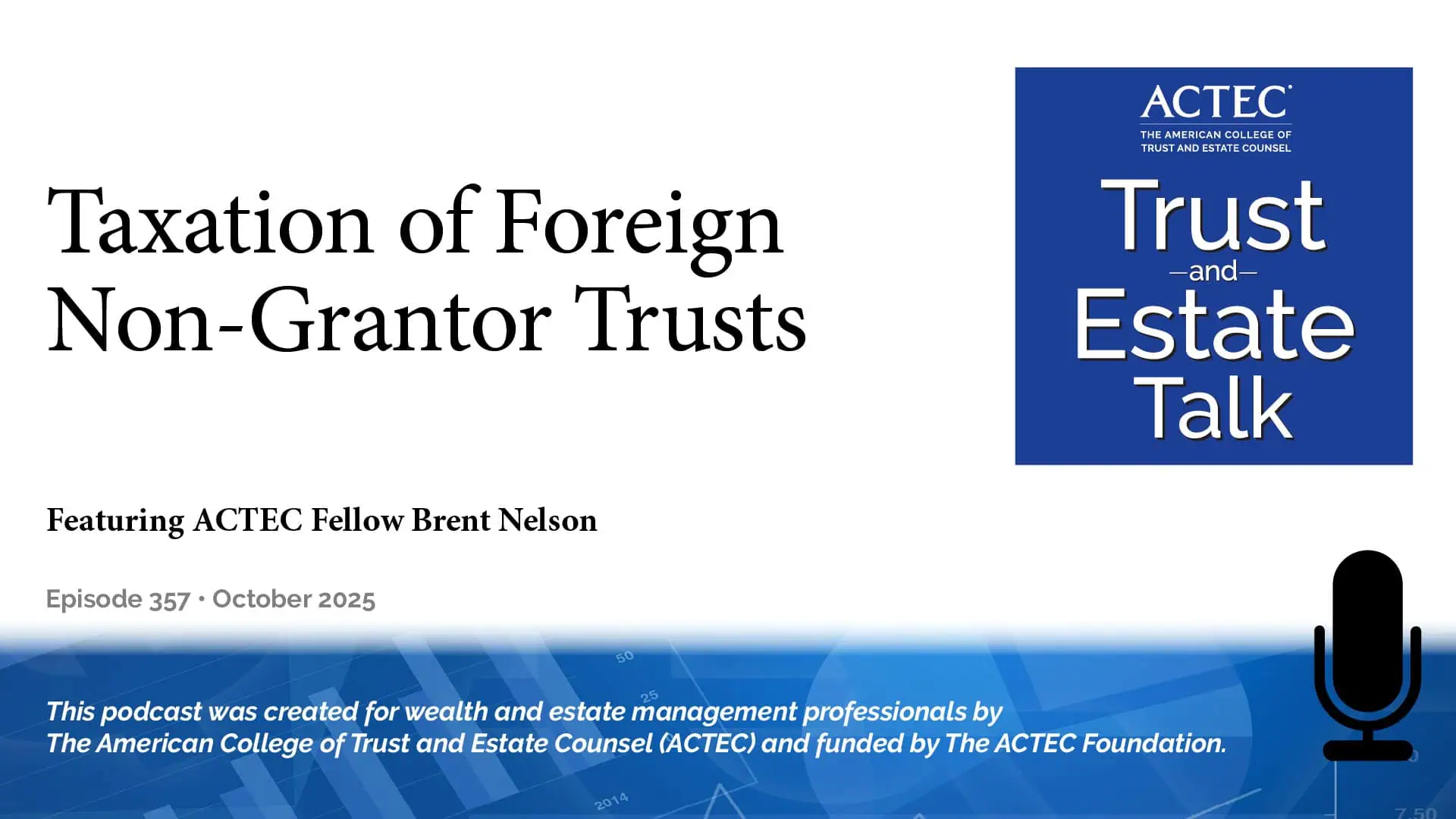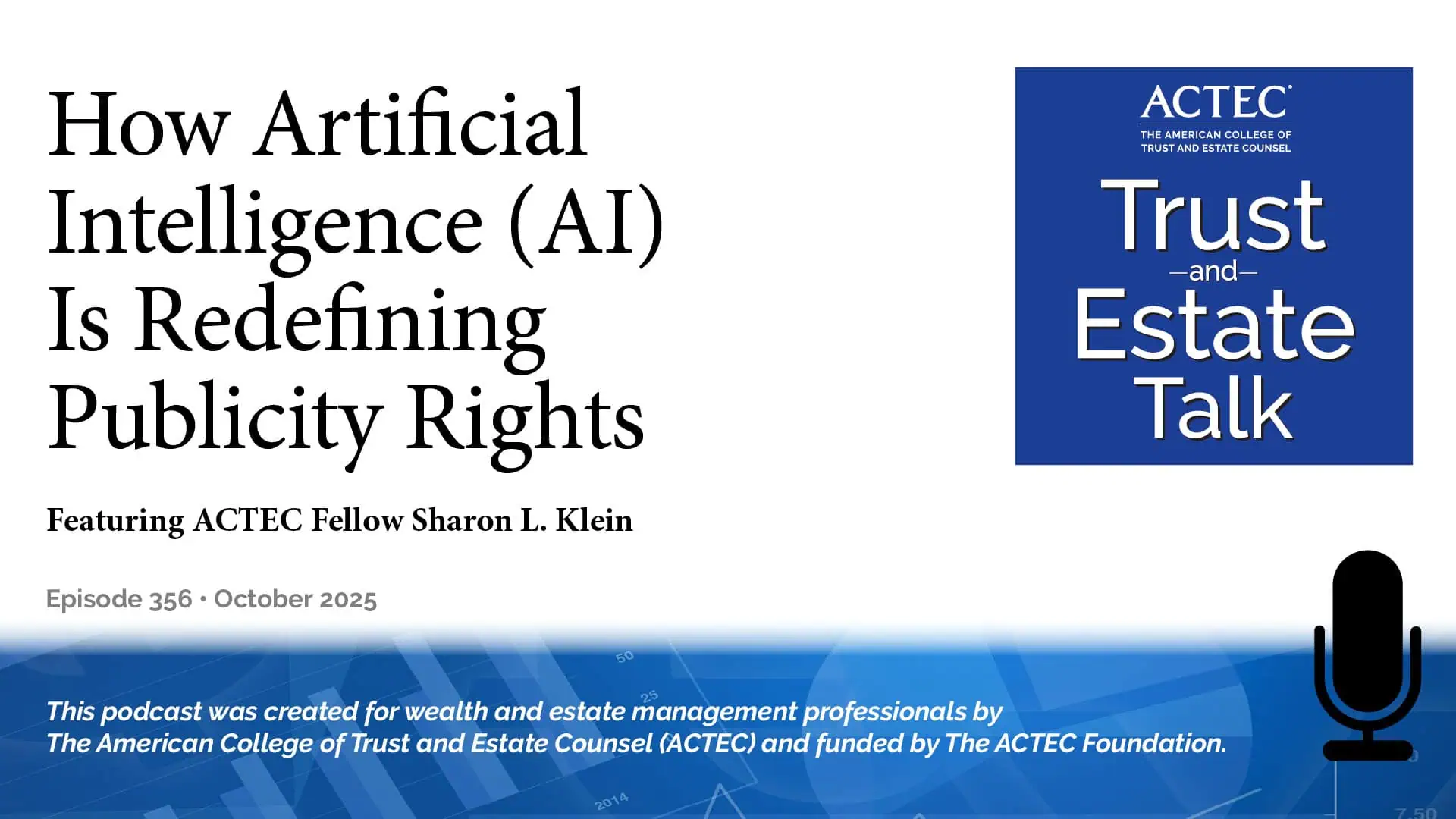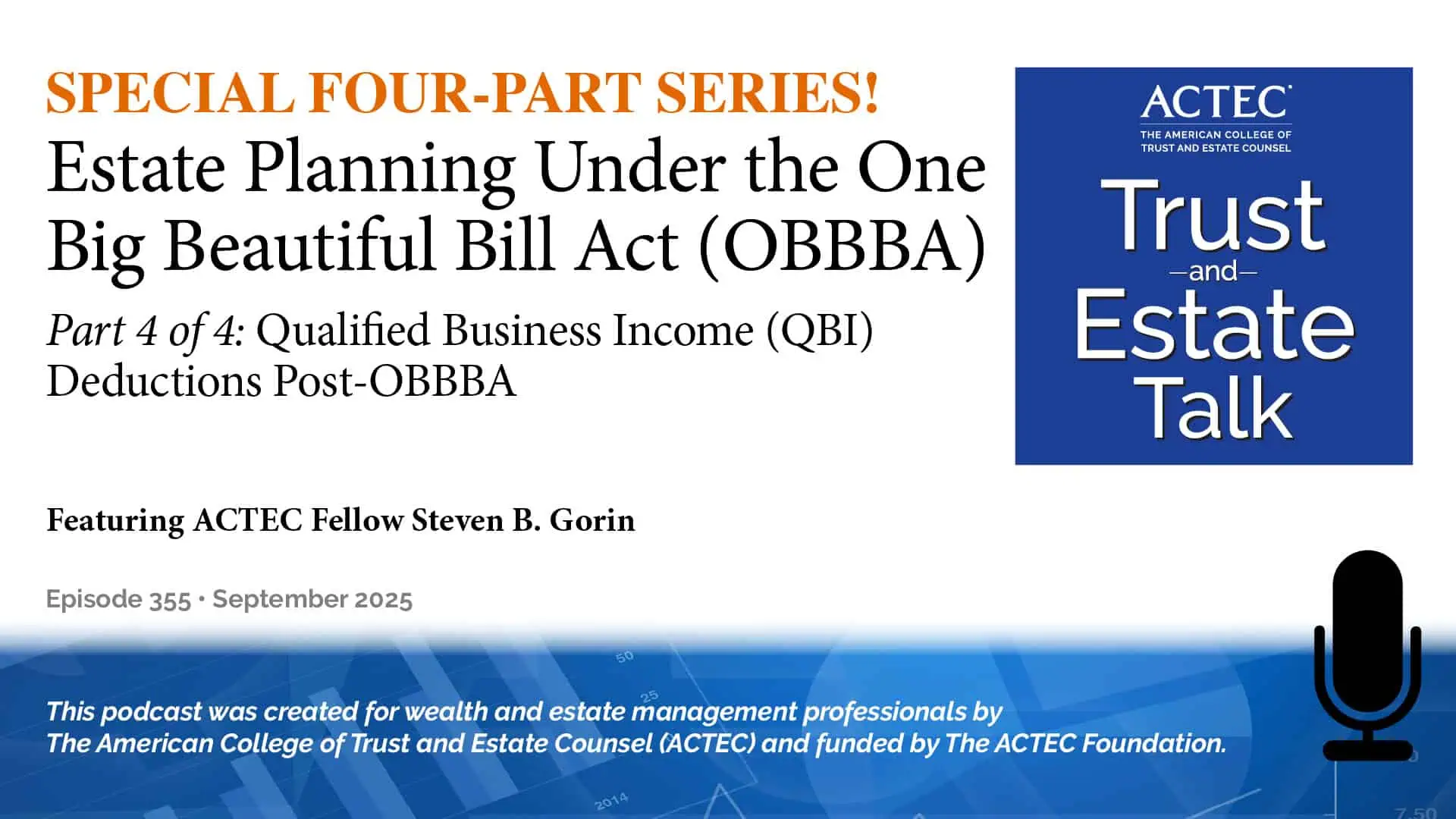S Corporation Death Traps
“S Corporation Death Traps,” that is the subject of today’s ACTEC Trust and Estate Talk.
Transcript/Show Notes
This is Ed Beckwith, ACTEC Fellow from Washington, D.C. If there is an S corporation, when the principal shareholder dies, is there a special tax consideration that needs to be addressed? To give us more information on this topic, you will be hearing today from ACTEC Fellows Brian Sparks of Tampa, Florida and Stacy Eastland of Houston, Texas.
Thank you. Unlike partnerships, which have a special mechanism in the Internal Revenue Code to allow for the adjustment of basis upon the death of a principal partner, we don’t have the same mechanism in the S corporation world, and that results in what I call the S corporation deathtrap. If in a given year an S corporation sells, let’s say, substantially all of its assets at a substantial gain, and then a shareholder dies, of course, that gain is going to pass out to that shareholder’s individual income tax return and be recognized. Of course, there will be a basis step-up for that in the shareholder’s stock but there’ll be no offset to the income tax liability that results from the gain recognition. So the trap is if the S corporation has that substantial gain in a given year and that shareholder’s interest is not liquidated in that same year, you can end up with a mismatch that causes the gain recognition in year one and taxation in year one, and then the basis step-up from both the 1014 date-of-death adjustment to fair market value, and then the gain on the sale of substantially all those assets that has passed out to the shareholder as well. So you end up with a substantial basis adjustment to fair market value as a result of date of death and then the gain from the sale of those assets; and so in year one you have a substantial gain that’s subject to tax; in year two you have a substantial capital loss that may or may not be deductible against any other activity that the estate has in that second year. So the advice is to make sure that if you have that sale, either before or after the year of death of a shareholder, that you also match that sale at the same time in the same tax year with the liquidation of that S corporation, so that the substantial increase in basis from both 1014 and the gain recognition is available to offset that gain recognition and result in zero tax.
Now, there are some ways to avoid that and adjust for that; and Stacy, I know you’ve got some ideas along that. Would you go ahead and share that with everyone?
Thank you, Brian. Yes, I think if you get these transactions all in the same tax year. So, let’s kind of fast forward. We have an executor; the sole owner of a subchapter S corporation passes away. Well, in that particular year we get a step-up in basis on the outside basis of the stock of a subchapter S corporation. Unfortunately, we have a situation in which the assets, the basis of the assets has not received a step-up, because as Brian explained, how the subchapter S rules work. What the executor could do is take the stock, the subchapter S stock, and place it inside of a single-member limited liability company (LLC). Then, what the executor could do is to cause a liquidation of the subchapter S stock. So, let’s have an example. Let’s suppose the stock had an inside basis of $5 million, but when the stock was worth $20 million and so we have a liquidation, we have the sale, and what happens is we have this $20 million outside basis, we have the sale of the $5 million asset that’s now worth 20, so that gives us 15 million of gain, so now the outside basis of the corporation is 35 million. If we then liquidate the outside basis, we have now matched up the capital loss with the capital gain. The other nice twist off this is if you have formed a limited liability company, the executor now has an outside basis of $20 million in the limited liability company and the assets also have a basis of 20 million. There’s another advantage to having the limited liability company in that we’ve preserved, just like it was the subchapter S, creditor protection; it’s particularly important if we have a business that has some risk to it. Another advantage of doing that is if we have a limited liability company, what is kind of neat is, what if the shareholder had three children: one living in California, one living in Maine, one living in Texas with different investment goals, different perspectives. Well, with a subchapter S corporation it’s very difficult to split it up if we don’t do this transaction that I’ve talked about because you have to have a business purpose to split up the corporation. Also, you have to have kind of an ongoing business, and that’s a rare circumstance that you could satisfy that, splitting it up into three parts. We’re out from under that burden if we have a limited liability company. If we have a limited liability company, it’s very easy to split it up into three parts.
I thought just for a couple of minutes I would mention something else that’s kind of interesting about subchapter S corporations in the post-mortem field, and that is if you had a credit shelter trust, let’s just say all the income is to go out to the surviving spouse, that could be easily converted. Many times there’s boilerplate in the document that even if it’s a complex trust, that all the family agrees it could become a simple trust. That sets up the possibility that we could then drop down the assets to a subchapter S corporation and turn that trust into QSST (Qualified Subchapter S Trust) and if we turn it into a QSST, or a QSST trust, then we have a big advantage because now, the beneficiary will be taxed on the income. It’ll be, he or she will be, the surviving spouse will be the deemed owner. What’s neat about that is no doubt the surviving spouse has his or her own assets. You could then sell into that Qualified Subchapter S Trust and it’s attractive to sell into for the surviving spouse because perhaps she is or he is the trustee, is entitled to all the income of the trust, perhaps has a power of appointment over that trust. So, it has a lot of control for his or her own benefit and so if you sell into it, even if the surviving spouse has low-basis assets, there shouldn’t be the initial capital gains tax selling in to that trust. Maybe in the early years, the surviving spouse primarily lives off the note payments; maybe in the subsequent years lives off the distributions or heavily off it. Now, to be able to sell into it and get that advantage, the surviving spouse also needs to contribute to that subchapter S corporation so that we’re selling subchapter S stock. Another requirement that perhaps we need is that the surviving spouse, when she sells into it or he sells into it and gets a note back, that you secure that stock — that subchapter S stock that’s sold into it — you secure it with that note; and then, the way the subchapter S rules work and the Principal and Income Act rules work, you can service not only the income but, if you will, the principal on the note. The interest on the note and the principal on the note.
One question I wanted to ask was when you’re forming that LLC into which you’re going to transfer the decedent’s S corporation stock, it’s going to make a disregarded entity election; is it not?
Yes.
So, it’s just a pass-through. We’re not going to have an LLC that elects to be a partnership. Of course, that would be an unpermitted shareholder and when you are talking about the division of the company for the family members, the rules you alluded to were the divisive reorganization rules under Internal Revenue Code Section 355, which are not available in a lot of instances when we have a mixture of family assets between business and investment in the entity. So, that’s great, Stacy. Thank you very much.
Yeah, and there are several private letter rulings saying that a limited liability company, if it’s a single member one, can own subchapter S stock, because to your very good point, it’s a disregarded entity for income tax purposes.
Great. Thank you.
Thank you.
Thank you, Brian and thank you, Stacy for sharing with us this important information.
Additional podcasts of interest:
This podcast was produced by The American College of Trust and Estate Counsel, ACTEC. Listeners, including professionals, should under no circumstances rely upon this information as a substitute for their own research or for obtaining specific legal or tax advice from their own counsel. The material in this podcast is for information purposes only and is not intended to and should not be treated as legal advice or tax advice. The views expressed are those of speakers as of the date noted and not necessarily those of ACTEC or any speaker’s employer or firm. The information, opinions, and recommendations presented in this Podcast are for general information only and any reliance on the information provided in this Podcast is done at your own risk. The entire contents and design of this Podcast, are the property of ACTEC, or used by ACTEC with permission, and are protected under U.S. and international copyright and trademark laws. Except as otherwise provided herein, users of this Podcast may save and use information contained in the Podcast only for personal or other non-commercial, educational purposes. No other use, including, without limitation, reproduction, retransmission or editing, of this Podcast may be made without the prior written permission of The American College of Trust and Estate Counsel.
If you have ideas for a future ACTEC Trust & Estate Talk topic, please contact us at ACTECpodcast@ACTEC.org.
© 2018 – 2025 The American College of Trust and Estate Counsel. All rights reserved.
Latest ACTEC Trust and Estate Talk Podcasts

Taxation of Foreign Non-Grantor Trusts
Learn how U.S. tax rules affect foreign non-grantor trusts and discover key strategies for cross-border estate planning and compliance.

How Artificial Intelligence (AI) Is Redefining Publicity Rights
Explore how AI, deepfakes, and digital replicas are reshaping publicity rights, estate planning, and legacy protection.

Qualified Business Income (QBI) Deductions Post-OBBBA
Learn how the One Big Beautiful Bill Act changes the Qualified Business Income (QBI) Deduction, expanding phase-in ranges and tax planning opportunities.



